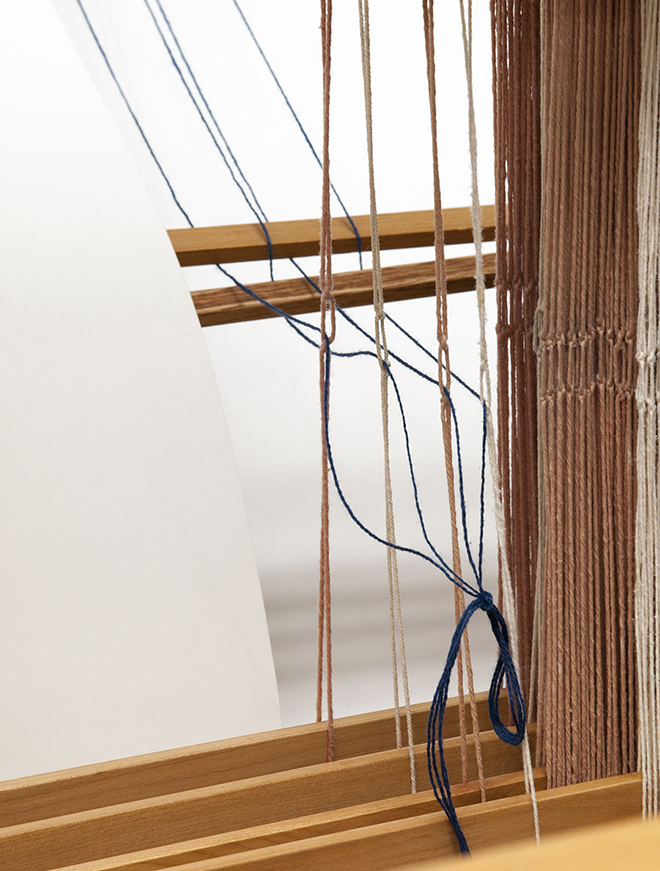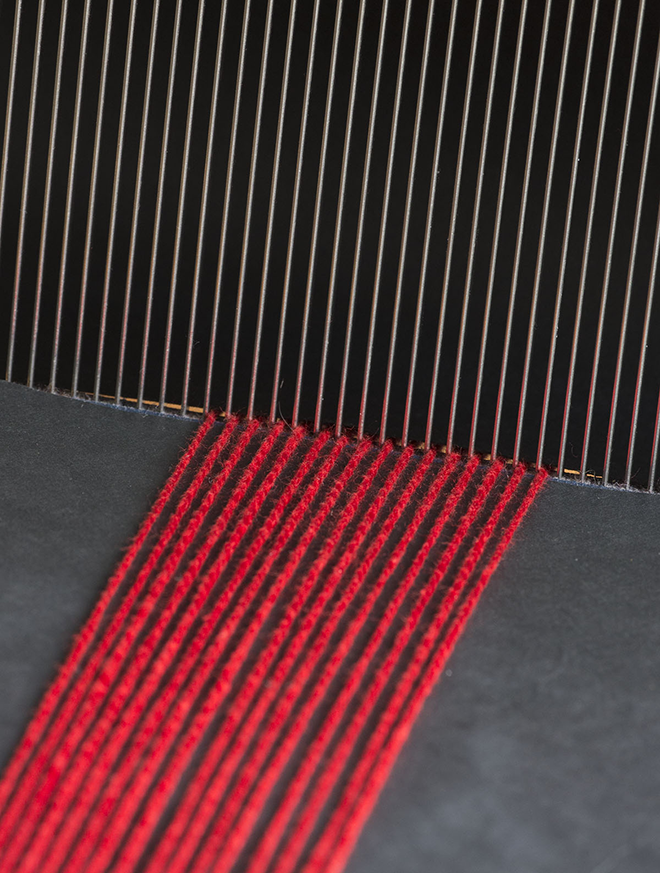| Focus on Beating |
Marcy Petrini
June, 2023
I am finally back teaching beginning weaving, after the long COVID pause. I love the enthusiasm of students dressing their looms and starting their projects.
Weaving has many technical parts. If followed carefully, we can avoid mistakes: winding the correct number of warp ends, threading the heddles, sleying the reed, tying the treadles. Relatively easy to check and easy to show students how to avoid the pitfalls, although it takes a bit of experience to learn it all.


Then it’s time to tie the warp and getting the tension even across its width. Not so cut and dried. I pat a student’s warp and I may say: “feel the second bout, it’s a bit looser than the others “. What does “a bit looser” mean, exactly? Students learn the way we have learned, feeling, trying and observing. When spreading the warp, if a section sags, it is not tied with the same tension as the others. It can fixed.

Finally, it is time to weave – with an even beat, meaning the same number of picks per inch (ppi) throughout the fabric. Not so cut and dried either!
For a balanced fabric we try a beat that matches the sett (ends per inch, epi). We may have to adjust. Maybe the pattern will show better if we beat a little more closely. Perhaps we want to beat a little more openly to avoid a stiff fabric.
Once decided on a beat, it must be maintained throughout the weaving. We measure often as we learn what the fabric should look like. In my class, beginners are weaving tabby at a sett of 12 epi. For a perfect tabby, the beat should be 12 ppi. However, I say that it’s ok if sometimes it’s 13 ppi, while others it’s 11 ppi. What we don’t want to happen is to creep up: first it’s 13, then 14, then 15 ppi, etc. until the fabric becomes stiff as cardboard! Loser and loser is also not good, but in my experience that doesn’t happen very often. It’s beating too hard that can be a problem. We need some space between threads (as shown by the arrow below), to allow for wet finishing to fill in.

When weavers demonstrate, to outsiders it looks like all we do is throw the shuttle. Beginners learn that they must pay attention to several things to make good cloth, including the treadling steps, the beat and the selvages.
For an even beat, the good question is: how often to measure? For my own weaving, I usually measure every time I start weaving. I take breaks often, but checking the number of threads in an inch is quick. I like to use an “incher”, which I normally use to determine the wraps per inch of a yarn, but of course a ruler or a measuring tape work just as well. If the fabric has a pattern, I can count the number of pattern repeats (and portions of it) in an inch rather than threads. Below there are 6 repeats, 4 picks each, for a total of 24 ppi.

Once weaving, I pay attention to the look of the fabric. “Stay in the moment” or “go with the flow” are phrases used to describe the concentration needed to accomplish the task.
Recently I found out how important paying attention really is. My 101-year-old Mom has been slowly deteriorating and as I write this, she is in hospice. I have always found solace in my handwork during difficult times. Watching this decline in my Mom has been painful and sad. I realized that I was distracted, too, but I didn’t realize how much until I looked at the current piece on my four-shaft loom, shown below.

It is a scarf, variegated orange silk warp with stripes of a different variegated silk. The weft is blue silk. You can see how varied the beat is throughout the small amount woven, approximately 7”. I see five different areas, ranging from weft dominant to too loosely beaten with elongated warp floats and everything in between. No treadling errors and the selvages are acceptable, but I just couldn’t stay focused to get the good rhythm needed for a good beat.
When the stress will be over, the weft will come off and I will rethink the project. Maybe another weft would give me a fresh start.
Happy weaving!
Marcy